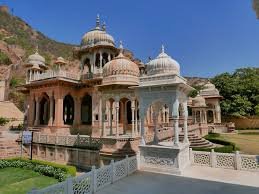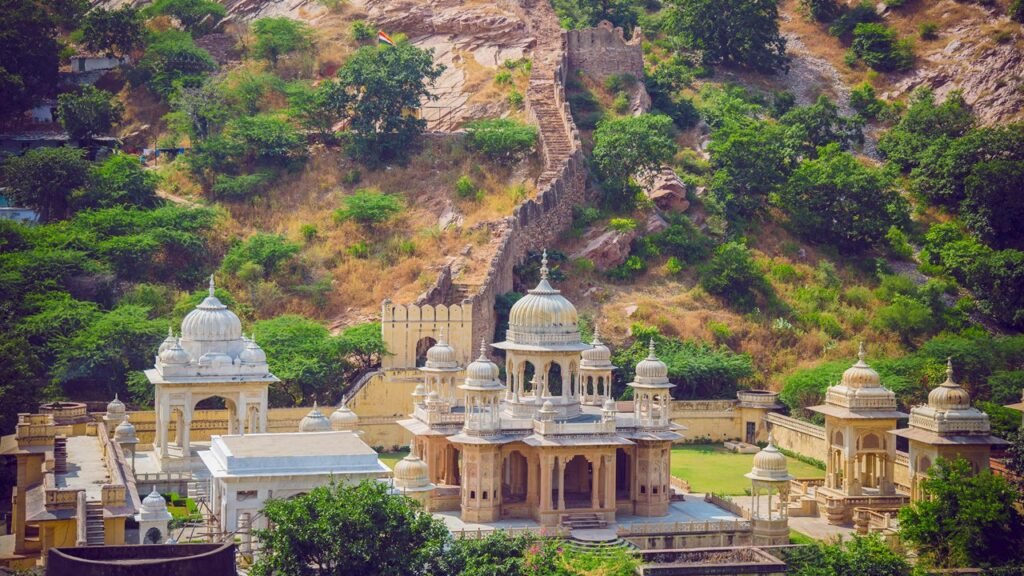Gaitore, Rajasthan, an evocative blend of art, history, serenity, and royalty, stands as a testament to the grandeur and culture of Jaipur’s Kachhwaha rulers. Nestled amid the Aravalli hills on the Jaipur-Amer road, just 15 km from Jaipur city, this royal cremation ground serves as an architectural and cultural heritage site that beautifully preserves stories of centuries past. Home to ornate cenotaphs, or ‘chhatris’, Gaitore attracts travellers searching for history, tranquility, and artistic inspiration.
Location and Route
Gaitore’s location on the Jaipur-Amer road places it at an intersection of heritage and accessibility. It lies just 15 km from central Jaipur, enveloped between Garh Ganesh Temple to the east and Nahargarh Fort to the west.
How to Reach:
- By Auto, Taxi or Bus: Local autos, taxis, and buses are readily available from Jaipur city.
- Best Time to Visit: From September to March, mornings or late afternoons offer the most favorable light for admiring its architectural details. Address: Gaitore, Jaipur-Amer Road, Jaipur, Rajasthan.
| Distance from Jaipur Railway Station | Approx. 8 km |
| Distance from Jaipur International Airport | Approx. 18 km |
| Entry Fee | ₹30 for Indian visitors |
| Timings | 9:00 AM to 5:00 PM |
Key Details:
Visiting Times & Cost
Every Major Thing
The Fascinating History of Gaitore
Gaitore’s significance dates back to 1733 when Maharaja Sawai Jai Singh II, the visionary founder of Jaipur, selected this site as the royal cremation ground for the Kachhwaha dynasty. The term ‘Gaitore’ is believed to come from the Hindi phrase “Gaye ka Thor,” meaning “resting place of the departed souls.”. From then on, every Kachhwaha king was honored here, except for Maharaja Sawai Ishwari Singh, whose cremation took place within the City Palace.
Each cenotaph at Gaitore was lovingly crafted to reflect the aesthetic preferences and accomplishments of the king it commemorates. The most striking of these is that of Maharaja Sawai Jai Singh II, made from luminous white marble and adorned with intricate peacock and floral motifs. Walking through this necropolis, visitors sense the weight of centuries, with every chhatri echoing the stories of bravery and culture.
Architectural Grandeur and Artistic Heritage
The cenotaphs at Gaitore are iconic for their harmonious blend of Hindu and Islamic architectural styles. Each structure is built as a domed pavilion perched atop raised, ornately carved platforms, reflecting the story, rank, and personality of each ruler.
Key Artistic Features:
- White marble used in principal cenotaphs, especially that of Jai Singh II, gleams beneath the Rajasthani sun.
- Motifs of peacocks, elephants, warriors, and floral patterns are seen carved in exquisite detail.
- The central cenotaph of Maharaja Sawai Jai Singh II boasts over 20 pillars, each one an ode to imperial craftsmanship.
- Traces of age-old murals and paintings can still be glimpsed, hinting at the original grandeur.
Gaitore is more than a royal cemetery, it is an architectural gallery where Rajasthan’s history comes alive in stone and story.
Culture Surrounding Gaitore
Gaitore is deeply rooted in Jaipur’s Rajput heritage, mirroring centuries of royal customs, rituals, and artistic endeavors. The fierce pride and cultural sophistication of the Kachhwaha rulers are evident in every chiselled pillar and colored motif. The tradition of commemorating departed rulers with meticulously-designed chhatris reflects a culture that revered artistry, honor, and historical memory.
Tourists visiting Gaitore will often find local guides narrating tales of valor, pride, and unresolved mysteries of Rajputana. Occasional religious events, especially near the death anniversary of Maharaja Sawai Jai Singh II in September, see the site buzzing with both locals and visitors, reinforcing the role of Gaitore in Jaipur’s living heritage.
Gaitore as a Tourist Spot
Though sometimes overshadowed by Jaipur’s grander palaces and forts, Gaitore is a unique destination for those seeking tranquility and unspoiled historical charm. Its peaceful ambience appeals to art lovers, historians, photographers, and anyone wanting a break from the city’s lively bazaars.
Nearby Attractions:
Gaitore is also rated as an Instagram-worthy destination, where early mornings and serene evenings offer perfect backdrops.

Economic and Revenue Impact
Tourism is one of the primary sources of revenue in Jaipur, and Gaitore, while not the most crowded tourist spot, contributes to the local and regional economy. Revenue is generated through entrance fees, guided tours, and auxiliary tourism such as nearby transport and dining.
Revenue Details:
- Entry fee is INR 30 per visitor, which is also included in the Jaipur City Palace composite ticket (INR 300 for Indians).
- Jaipur’s annual tourism contributes significantly to Rajasthan’s economy, employing thousands directly and indirectly through sites like Gaitore.
- Heritage sites foster local handicraft sales, guide employment, and related hospitality income, supporting Jaipur’s emergence as a top-visited city in India.
FAQs About Gaitore
What is the significance of Gaitore?
It is the royal cremation ground for the Kachhwaha Rajput rulers of Jaipur, chosen by Maharaja Sawai Jai Singh II in the 18th century.
Where is Gaitore located?
It is located on the Jaipur-Amer road, about 15 km from Jaipur’s city center, accessible by local taxis, autos, or buses.
What are the entry fees and timing for Gaitore?
Indian visitors pay ₹30 per person; composite tickets are available. The site is open from 9:00 AM to 5:00 PM daily.
Which is the most famous cenotaph at Gaitore?
The cenotaph of Maharaja Sawai Jai Singh II is the most renowned, made of white marble and beautifully adorned with peacock and floral motifs.
What architectural style is Gaitore known for?
It’s chhatris blend Islamic domes and Hindu temple design, showcasing Rajput splendor with intricate carvings and murals.
What can tourists do at Gaitore?
Tourists can explore the cenotaphs, enjoy quiet reflection, click photographs of exquisite carvings, and visit nearby tourism hot spots.
Visitor Tips and Travel Insights
- Best Time to Visit: September to March. Early mornings are preferred for soft sunlight and quieter atmosphere.
- Clothing Recommendation: Modest and comfortable clothing, hats, and sunscreen for sun protection.
- Nearby Refreshments: Carry water and light snacks; roadside stalls are available closer to Amer and Jaipur.
- Combine with Other Sights: Gaitore makes a great addition to a Jaipur itinerary featuring Amber Fort, Nahargarh Fort, and City Palace.
Gaitore in Modern Jaipur
Despite its calm, Gaitore is increasingly recognized as one of Jaipur’s hidden gems, charming both heritage lovers and casual tourists alike. Many travelers rank the site as one of the city’s most peaceful attractions, with guides often sharing anecdotes lost to grander palaces. Social media has given it a new lease of life as a must-see spot for art, history, and photography lovers, leading to steady growth in visitor numbers.
Contribution to Rajasthan’s Heritage
Gaitore brings together threads of family, memory, and art, articulating a harmonious dialogue between life and death, culture and nature. The site is a lasting reminder that Rajasthan’s greatness lies as much in its subtle memorials as its majestic forts. Every pillar, dome, and mural here reverberates with a sense of continuity between the vibrant present and the legendary past.
Recent News
In a major cultural initiative, Gaitore’s world-renowned cenotaphs are set to host Jaipur’s upcoming Grand Heritage Festival, a move anticipated to shine a fresh spotlight on Rajasthan’s royal past while nurturing sustainable tourism for the next decade.
Government officials, local artisans, and members of the erstwhile royal family announced plans to integrate traditional arts, guided walks, and community heritage events within the evocative setting of the Gaitore necropolis. The festival is projected to boost tourism revenue, empower local businesses, and secure new funding for ongoing preservation of it’s iconic chhatris and centuries-old murals. Heritage experts emphasize that such events not only attract global travelers hungry for authentic cultural experiences but also foster grassroots participation and pride among Jaipur’s residents. As it prepares to merge the legacies of its legendary Maharajas with the vibrancy of modern Rajasthan, the royal resting place is poised to become a flagship destination for heritage and spiritual tourism in India’s Pink City.
